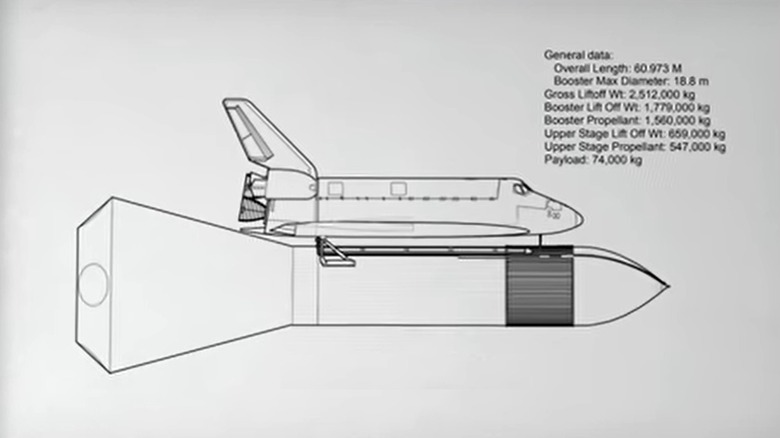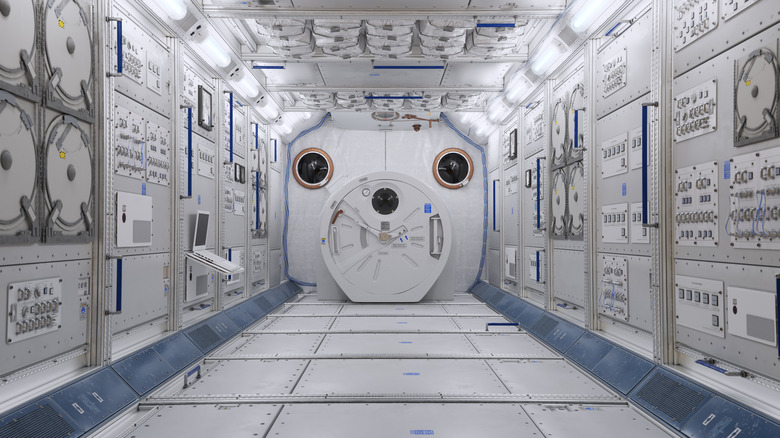The Unbelievable NASA Space Shuttle Designed To Carry 86 Astronauts At Once
The course of human space exploration has been dynamic, to say the least. Changes in circumstance have led to drastic course corrections that have seen mission focus change in a heartbeat. One obvious example is in the decision to stop exploring the Moon after the Apollo 17 mission returned from its surface in 1972.
In another reversal, NASA is in the midst of a retool taking place today that aims to see humans back out beyond Earth's orbit and standing on the Moon once more. Artemis I has successfully rocketed around the lunar body and returned to Earth. Artemis III, which is slated for 2025, will carry humans back to the Moon and perhaps kick off a new age of exploration beyond our planet's surface.
In considering the future of exploration to the Moon and beyond — Mars, perhaps? — it's worth thinking about how NASA will move all of the people and gear that will brave that great beyond. One option may be to look backward at a shuttle design that was intended for high capacity people movement (with a maximum capacity of 86).
An early draft of the space shuttle from the 1970s would have looked a lot more like a bus or airplane than the finished product that eventually flew 135 total missions before landing for the final time in July 2011. The design is both intriguing and a potential starting point for the future of human spaceflight.
This alternative space shuttle design was focused on passengers
In 1976, NASA was drawing up plans to develop a series of large space stations that would sit in high Earth orbit. Stations would run on solar power and would have been much larger than the Skylab space station that had recently been closed, as well as the MIR and International Space Stations that would come later. But in order to operate these larger stations, NASA and partner agencies around the world would need to develop a reliable means of bringing large crews up into orbit on a regular basis.
Fortunately, Rockwell and Boeing had each built large freight-type space vessels that could handle this mission — the "Star Raker" and "Space Freighter," respectively. But neither of the models were designed for passenger flight, only the transportation of essential cargo. Therefore, Rockwell began work designing the "Personnel Launch System," what essentially might be described as a large space shuttle.
The framework of the shuttle that would eventually come into being was already in the works, so piggybacking off of this design made complete sense. A smaller version of the Star Raker was proposed, but the shuttle and large, single booster combination proved cheaper to create upfront and was chosen as the favored design. However, the space station project was eventually scuttled, and with it the need to build a fleet of large people movers.
The future of space flight may return to varied model usage
As distance plays an ever increasing role in success or catastrophe, new space flight models will likely be designed. NASA will likely be seeking to create continuous habitation farther out into the universe. There's been talk of building permanent settlements on the Moon, and even an interest in mining the Moon's surface for resources. To accomplish this, NASA and other spacefaring agencies will certainly need to return to these ideas surrounding the transportation of vast material loads and astronauts.
It's probable that a transition back into surface exploration by humans, and a future endeavor to create lasting habitation, will require a branching out of space-capable transportation. Moving people is very different from lifting gear out into the vacuum of space. Life support systems, personal safety devices, and even bathrooms and food will need to be included in any ship design that will carry passengers.
Devising multiple rocket types to efficiently lift personnel and goods into space is likely the best approach, and it may call for a revised design on this old classic. Of course, the space shuttle program turned out to suffer from a variety of launch capability problems, and was eventually shuttered. Even so, this schematic might offer itself as a great starting point for future construction.

